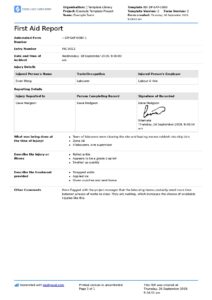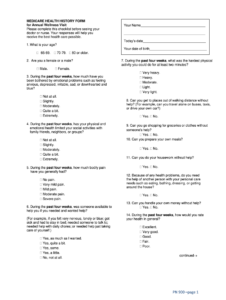Managing hypertension, or high blood pressure, effectively is crucial for patient health. As healthcare providers, we all know the importance of meticulous documentation in delivering optimal care. Accurate and comprehensive records not only aid in informed decision-making but also ensure continuity of care and proper billing. But let’s be honest, sifting through notes and remembering every single detail about a patient’s blood pressure history can be time-consuming. Wouldn’t it be great if there was a way to streamline this process?
That’s where a hypertension documentation template for providers comes in handy. It provides a standardized framework for recording relevant patient information, ensuring consistency and completeness in your documentation. Think of it as a cheat sheet that helps you capture all the essential details, from blood pressure readings and lifestyle factors to medication history and physical exam findings. It’s a tool to help you become more efficient and confident in your management of hypertension.
In this article, we’ll dive deep into the benefits of using a hypertension documentation template for providers and how it can significantly improve your clinical workflow. We’ll also explore the key elements that should be included in a well-designed template and provide practical tips for implementing it effectively in your practice. Get ready to say goodbye to documentation headaches and hello to streamlined, efficient hypertension management.
Why a Standardized Hypertension Documentation Template Matters
A standardized hypertension documentation template for providers isn’t just about making life easier, although it certainly does that. It’s about enhancing the quality of care you provide to your patients. Imagine having all the relevant information at your fingertips, organized in a clear and concise manner. This is the power of a well-structured template.
First and foremost, it promotes consistency. By using the same template for every patient with hypertension, you ensure that you’re collecting the same core data points across the board. This consistency allows for easier comparison of patient progress over time, enabling you to identify trends and adjust treatment plans accordingly. It also reduces the risk of overlooking important details, such as medication side effects or lifestyle factors that may be contributing to the patient’s condition.
Secondly, a template can significantly improve communication among healthcare professionals. When multiple providers are involved in a patient’s care, a standardized template ensures that everyone is on the same page. This is especially important in settings like hospitals or large clinics, where different doctors may see the same patient at different times. Clear and consistent documentation facilitates seamless transitions of care and prevents miscommunication that could potentially compromise patient safety.
Furthermore, using a structured hypertension documentation template for providers can help you meet quality reporting requirements. Many healthcare organizations are now required to report on specific quality measures related to hypertension management. A well-designed template can simplify the process of collecting and reporting this data, saving you valuable time and resources. It can also help you identify areas where your practice may need to improve its performance in managing hypertension.
Beyond all of that, using a template simply saves time. Rather than constructing a note from scratch each time, you can fill in the template with relevant information. This increases efficiency and allows you to spend more time directly interacting with your patients. The time saved on documentation can be reinvested in providing more comprehensive care, leading to better outcomes and increased patient satisfaction.
Essential Elements of a Hypertension Documentation Template
A comprehensive hypertension documentation template should include several key elements to ensure that all relevant information is captured. This might include demographic data, past medical history, family history of hypertension or cardiovascular disease, a detailed medication list, and any allergies. Be sure to include a section for recording blood pressure readings, including both systolic and diastolic measurements, and the date and time they were taken. The more detailed the record, the better the care provided.
Key Components to Include in Your Template
To create an effective hypertension documentation template, it’s important to incorporate specific components that capture all the necessary information for comprehensive patient care. This will enable you to better manage hypertension and track patient progress.
Firstly, a detailed patient history section is crucial. This includes information about the patient’s medical history, family history of hypertension or cardiovascular disease, lifestyle factors (such as diet, exercise, smoking, and alcohol consumption), and any other relevant medical conditions. Understanding the patient’s overall health profile is essential for developing an appropriate treatment plan.
Secondly, a dedicated section for recording blood pressure readings is a must-have. This should include space for multiple readings taken at different times, as well as the patient’s position (sitting, standing, or lying down) and arm used for measurement. Consistent and accurate blood pressure monitoring is essential for tracking treatment effectiveness and making informed decisions.
Thirdly, incorporate a section for documenting medication information. This should include the names, dosages, frequencies, and routes of administration for all medications the patient is taking, including both prescription and over-the-counter drugs. It’s also important to document any medication allergies or adverse reactions the patient has experienced. Being aware of a patient’s medications is critical for preventing drug interactions and ensuring medication adherence.
Fourthly, be sure to have a section for documenting physical exam findings relevant to hypertension. This may include assessing the patient’s heart, lungs, and peripheral pulses, as well as checking for signs of end-organ damage, such as retinopathy or kidney disease. Physical exam findings can provide valuable clues about the severity and impact of hypertension on the patient’s body.
Finally, include a section for documenting patient education and counseling. This should include information about the lifestyle modifications recommended to the patient, such as diet changes, exercise, and smoking cessation. It’s also important to document the patient’s understanding of their condition and their willingness to adhere to the treatment plan. Patient education and engagement are essential for achieving successful hypertension management.
Streamlining your hypertension documentation process through the use of a template is an investment in better patient outcomes. This focused approach makes it easier to follow best practices for hypertension management.
Remember, the ultimate goal is to provide the best possible care for your patients. Embrace the power of structured documentation, and you’ll be well on your way to achieving that goal.



